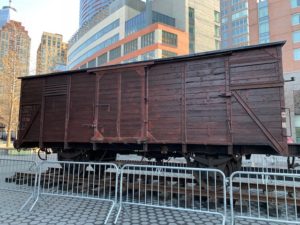This past Sunday, a German cargo train car, like those used to transport men, women and children to Auschwitz and other Nazi concentration camps, arrived at the Museum of Jewish Heritage – A Living Memorial to the Holocaust. The arrival of the freight wagon comes a short time before the opening of the exhibition “Auschwitz. Not Long Ago. Not Far Away”, which will take place on May 8th, 2019.
As I walked towards the Museum on a sunny spring day, I prepared myself for the encounter with this artifact, the likes of which had most likely transported the entire family of my mother, as well as my father’s parents and four sisters, from the Ghetto to their death.

Nothing can prevent the visceral dread that washed over me at the sight of this sturdily built, windowless, wooden wagon, with its robust doors hanging on massive metal hardware, a thick pin stuck in a large hole that locked 80 to 100 people into this inescapable boxcar. No food. No water. No lavatory. No room to sit. Merciless journey to a gruesome death.
Over the last couple of weeks, the Museum has scheduled multiple meetings, in which I participated. The purpose of the meetings was to have a diagogue with the survivors who act as docents and educators, with the Museum staff, and with the community in the geographic vicinity of the Museum, where they could discuss, process and prepare for the potential reactions they might have to the arrival of this massive artifact which will be now stationed for a year at the front of the entrance to the Museum, outside the Museum walls, in plain sight on the street, where the public, not just Museum visitors, will see it. There were many thoughtful concerns and feelings expressed during these meetings.
But as I stood there today, shaken, next to this abomination, it felt right to have the freight car there. It felt necessary and right for it to stand in full view, to come outside of the walls of the Museum, and to claim its place in the physical public space, perhaps even intruding upon the mental equanimity of passers-by. These are strange times, in which the dangers of the past feel eerily less far and less removed than they ought to be. Let the car stand there, let its silent presence speak.
Irit Felsen

A beautifully and poignantly written article, Irit.
Look forward to meeting you later today at the 2G meeting.
Felice Salmon
Thank you, and looking forward to meeting you at the 2G meeting this afternoon.
Irit Felsen